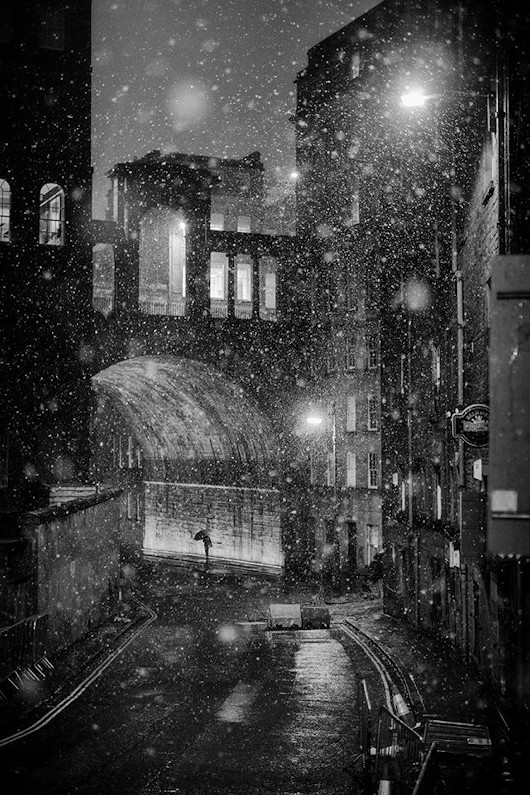Edinburgh
About Andrew Cusack
 Writer, web designer, etc.; born in New York; educated in Argentina, Scotland, and South Africa; now based in London.
Writer, web designer, etc.; born in New York; educated in Argentina, Scotland, and South Africa; now based in London. read more
News
Blogs
Reviews & Periodicals
Arts & Design
World
France
Mitteleuropa
Knickerbockers
Argentina
The Levant
Africa
Cape of Good Hope
Netherlands
Scandinavia
Québec
India
Muscovy
Germany
Academica
The Red Mass in Edinburgh
The opening of Scotland’s judicial year was marked this past Sunday by the Archbishop of St Andrews & Edinburgh offering the customary Red Mass in St Mary’s Cathedral.
This year Archbishop Leo Cushley was joined by Lord Drummond Young and his fellow Senators of the College of Justice, Lord Uist, Lord Doherty, Lord Matthews, and Lady Carmichael.
Gordon Jackson QC, the Dean of the Faculty of Advocates, and Austin Lafferty of the Law Society of Scotland joined many sheriffs, QCs, advocates, solicitors, trainee solictors, paralegals, and law students.
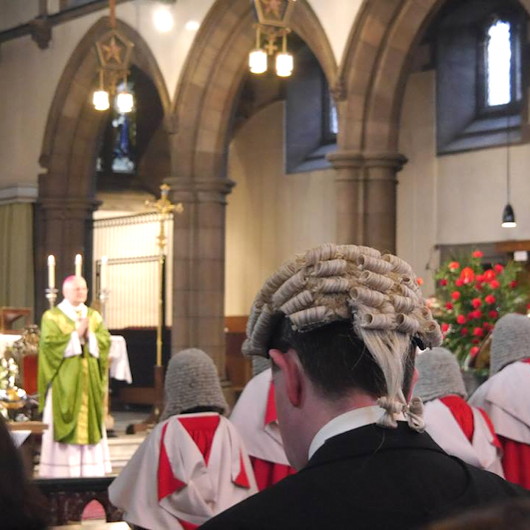
“These men and women serve the nation in a high office and come here to ask the Lord’s blessing upon this year’s work that they carry out on our behalf,” Archbishop Cushley noted in his homily.
“Know that we appreciate the difficult and complex tasks that you have and the duties that you perform – which are very onerous – on behalf of us all and that you be assured of our prayers and our support for all that you do to apply the law of the land with virtue and with justice and with mercy.”
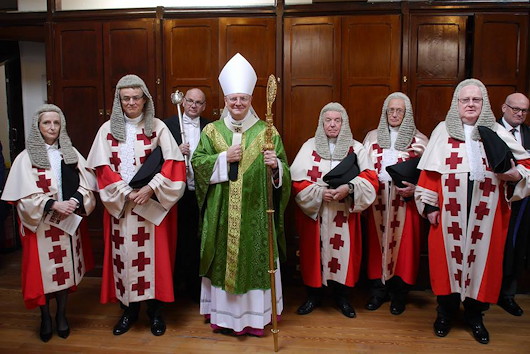
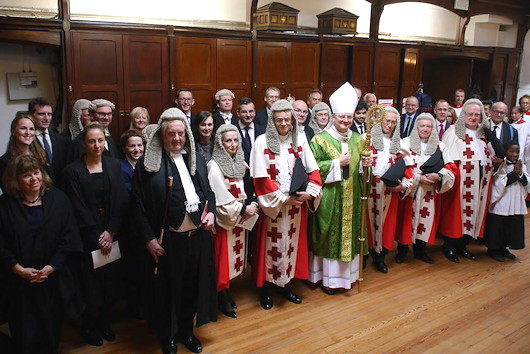
The Palace of Holyroodhouse
HOLYROOD IS SUCH a pleasant spot, despite the recent intrusion of an ostentatiously ugly government building designed by a Spanish architect. The other day, while visiting Edinburgh, I heeded the recommendation of the Prettiest Schoolteacher in Clackmannanshire to sample the burger at the Holyrood 9a. It was quite delicious, though not perfect, and was splendidly washed with a pint of Kozel (most un-Caledonian, I concede, but you can get Deuchars in London, you know).
Afterwards, our little party decided to have a little wander down Holyrood Road towards the Palace of Holyroodhouse, the epicentre of the Scottish monarchy.
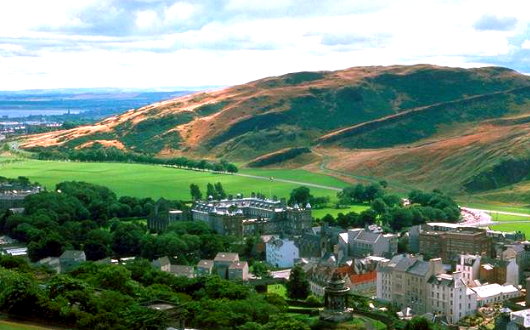
Nestled between Calton Hill and Salisbury Crags, the Palace sits at the end of the Royal Mile that runs between it and Edinburgh Castle. With the Old Town to its west, the expanse of Holyrood Park flows off to the south and east of it. (more…)
Edinburgh Update
Well, I was going to direct you over to Seraphic’s blog for an at least partial account of my Edinburgh weekend but she’s done gone and taken the dagnabbed thing down. It’s just as well, as when she described the assembled guests at a long Sunday lunch by the sea in Portobello she finished her description with “and Andrew Cusack wearing something rumpled from Ralph Lauren”. In fact, it was Massimo Dutti, but there you have it. (more…)
Fra Freddy, Rest In Peace
Yesterday, I was very saddened to hear of Fra Freddy’s death. Fra Freddy was a legendary character whom I was introduced to in my first year at St Andrews. He was invited to speak to the Catholic students most years on some subject or another — an introduction to prayer or a lenten meditation. I was quite pleased when he was so taken with a poster I designed to advertise one of his talks that on his way back to Edinburgh he nipped out of the car at the last minute and grabbed a large copy. Fra Freddy was an old-fashioned stick-in-the-mud with a good sense of humour, but he also had the capability to surprise with a kind word when you least expected it.
Fra Fredrik John Patrick Crichton-Stuart was born September 6, 1940 to Lord Rhidian Crichton-Stuart (son of the 4th Marquess of Bute) and his wife Selina van Wijk (daughter of the Ambassador of the Queen of the Netherlands to the French Republic). He was raised in Scotland and North Africa (where his father was British Delegate to the International Legislative Assembly of Tangier) and was educated first at Carlekemp in North Berwick and then at Ampleforth. He joined the Order of Malta in 1962, later being named the Delegate for Scotland & the Northern Marches. In 1993 he was appointed Chancellor of the resurrected Grand Priory of England. Fra Freddy became Grand Prior himself when his cousin, Fra Andrew Bertie, died in 2008 and was succeeded by the then-Grand Prior of England, Fra Matthew Festing.
Fra Freddy was a devoted follower and promoter of the traditional form of the Roman rite. He joined Una Voce Scotland in 1996 and became secretary in 2000. Two years later he was named councillor and senior vice-president of FIUV, the International Federation ‘Una Voce’, and briefly served as its president in 2005.
Over the past year or so Fra Freddy had been varying ill but seemed to recover. I am told he was found dead yesterday morning, still clasping his breviary. He was well-known in Edinburgh and beyond, and he will be missed by his many friends as well as those who worked and volunteered with him or interacted with him in his charitable activities.
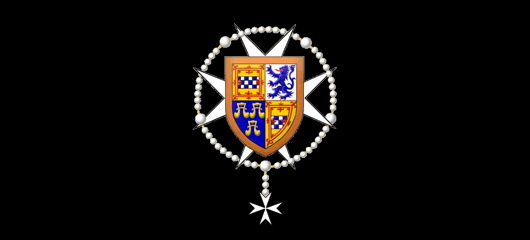
FREDERICK JOHN PATRICK CRICHTON-STUART
Grand Prior of England
of the
Sovereign Military & Hospitaller Order of St John
of Jerusalem of Rhodes and of Malta
6 September 1940 – 14 June 2011
Eternal rest grant unto him, O Lord,
and let perpetual light shine upon him.
May he rest in peace.
Amen.
The Highest Order in the Land
The Most Ancient and Most Noble Order of the Thistle
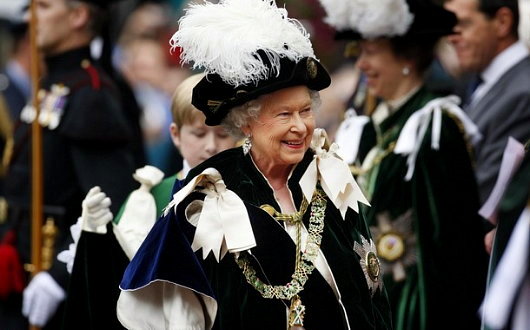
In 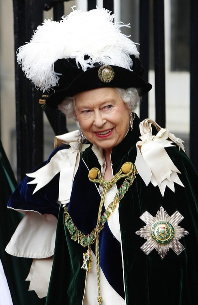 accordance with tradition, knights are appointed to the Order of the Thistle on the feast of Scotland’s patron saint, the Apostle Andrew, but they are not formally installed until the following summer when the Queen is in residence at the Palace of Holyroodhouse. And so this past July, the ‘Thistle Service’ took place at St. Giles’, the High Kirk of Edinburgh, and two new knights were inducted into Scotland’s highest honour and most exalted order of chivalry.
accordance with tradition, knights are appointed to the Order of the Thistle on the feast of Scotland’s patron saint, the Apostle Andrew, but they are not formally installed until the following summer when the Queen is in residence at the Palace of Holyroodhouse. And so this past July, the ‘Thistle Service’ took place at St. Giles’, the High Kirk of Edinburgh, and two new knights were inducted into Scotland’s highest honour and most exalted order of chivalry.
The knights, dames, and officers, dressed in their flowing velvet mantles of green along with their hats and collars, gather across Parliament Square in the Library of the Society of Writers to Her Majesty’s Signet (Scotland’s professional body of solicitors), part of the Parliament House complex that long ago housed the kingdom’s legislature, and is now home to her courts. In Parliament Square itself, the Royal Company of Archers (the Queen’s Body Guard for Scotland) forms a guard of honour and is accompanied by the band of the Royal Regiment of Scotland. (more…)
A Palace on Princes Street
The North British & Mercantile Insurance Company, No. 64 Princes Street
PRINCES STREET IS the thoroughfare of the nation, and its sad decline during the second half of the twentieth century and only partial comeback since then are reflective of Scotland itself. The architects of Edinburgh’s New Town had no idea that Princes Street would evolve into a commercial avenue, and the street was originally laid out as a handsome row of Georgian townhouses, built between 1765 and 1800, facing Princes Street Gardens and the Old Town above behind them.
Almost immediately the mercantile and social nature of the street began to assert itself, with shops and traders setting themselves up in the converted basements and ground floors of townhouses. The New Club showed up at No. 86 Princes Street in 1837, coming from previous premises in St. Andrew’s Square and before that Shakespeare Square (where the former G.P.O. now stands).
As the Victorian era progressed, more and more of the Georgian townhouses were demolished and replaced with new buildings in the varying styles of age. It was just two years after Victoria’s death that an old company built a new headquarters in a brimming Edwardian baroque: the North British and Mercantile Insurance Company. (more…)
‘Love over Parliament House’
Persuant to our discussion regarding Scotland’s three parliament buildings, Scots Law News reports that the Caledonian scribe Alexander McCall Smith has been called to the Scots bar.
Kidnap and Rescue
Followers of Seraphic’s blog will doubtless have read of my Caledonian misadventure, whereby I was kidnapped by the inhabitants of an historic house in East Lothian. This update was followed by the Sexagesima Social Report, detailing our Sunday Mass, followed by the Cup of Tea of Peace, followed by the Gin & Tonic of Fortitude. Pleasant as my enforced captivity was, various duties in London obliged me to cooperate with the successful rescue effort made, curiously, by Royal Dutch Commandos.
Further ruminations on my Britannic sojourn are forthcoming.
The End of India Street
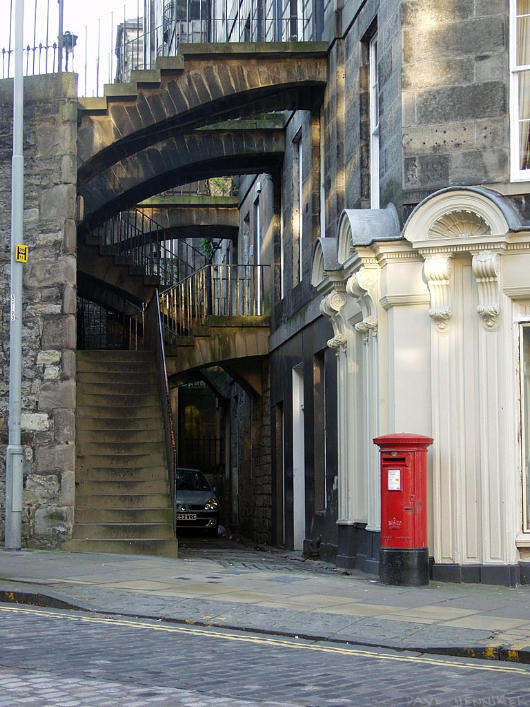
Photograph by Dave Henniker.
Separated at Birth?

Jean-Christophe, Prince Napoléon (left) and Christian de Lisle (right).
All Edinburgh is currently swamped with rumours that Christian de Lisle (who among other things is Keeper of the Faith of the Diagnostic Society) is actually a member of the House of Bonaparte. His carefully constructed English identity is believed to be merely part of the latest intrigue in the long-standing Bonapartist plot to seize England for France.
Previously: Lookalikes
Richard Demarco
“We didn’t know quite how to take this, but we sat there entranced.”
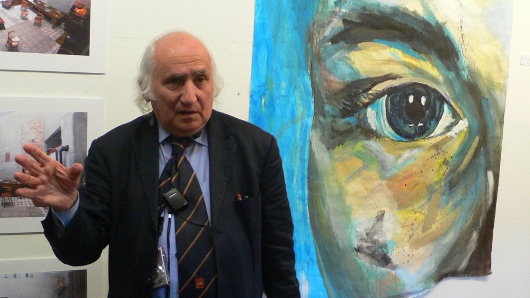
ONE OF THE markedly few deficiencies of the English language is coming up with a word to describe Richard Demarco. The Scottish press have generally settled upon “impresario” but even that somewhat-ambiguous word fails to do the man justice. Ricky was born in Edinburgh in 1930, grew up in Portobello, and remembers the day when his mother held him back from school because Italy — from whence he stock came — had just declared war on Great Britain. He’s attended every Edinburgh Festival since the very first one began in 1947 — as the founders put it, to “provide a platform for the flowering of the human spirit” in the grim aftermath of the Second World War.
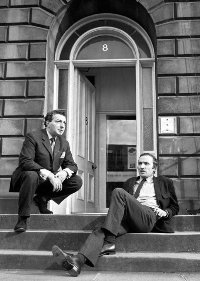 Richard Demarco, couchant, with noted Scots caricaturist Emilio Coia.
Richard Demarco, couchant, with noted Scots caricaturist Emilio Coia.In 1963, he cofounded the Traverse Theatre, Scotland’s theatre for new writing, and three years after that founded the Richard Demarco Gallery which promoted Scotland’s cultural interchange with artists across Europe including — very importantly to Richard — from behind the Iron Curtain that divided the continent into free and captive halves. This was during an age when many in the arts world were too busy sympathizing with the murderous totalitarianism that had subjugated half of Europe. Richard has been a deep critic of the choices made by the British government as patron of the arts throughout the decades of his life, but not too long ago he finally patched things up with the Scottish Arts Council.
Readers of Alexander McCall Smith’s 44 Scotland Street might recall the man who comes to speak to the Scottish Police College. The “really important person from the art world in Edinburgh”, as Mr. McCall Smith puts it, comes and tells the trainee constables about the gorgeousness of Italian carabinieri uniforms and how the Scottish psyche still suffers from the iconoclasm of the Reformation, and even suggests architectural alterations and more sympathetic decoration of the Police College. “We didn’t know quite how to take this, but we sat there entranced,” the character admits in 44 Scotland Street. Anyone who either knows Ricky or has been to one of his lectures would immediately recognize the unnamed subject of the passage.
I first met the man when I was a first-year student at St Andrews and he had come up from the capital to give a lecture. I can’t remember what the stated subject was but this is entirely irrelevant as so vast and wide-ranging is the mind & experience of Richard Demarco that he is known for (some would say “notorious for”) never keeping within the bounds of the stated subject. Those who invite Richard to speak shouldn’t bother with a subject, just make posters stating “RICHARD DEMARCO SPEAKS”, giving the date, time, and place, and a crowd of interested characters is bound to turn up. (more…)
An Early Proposal
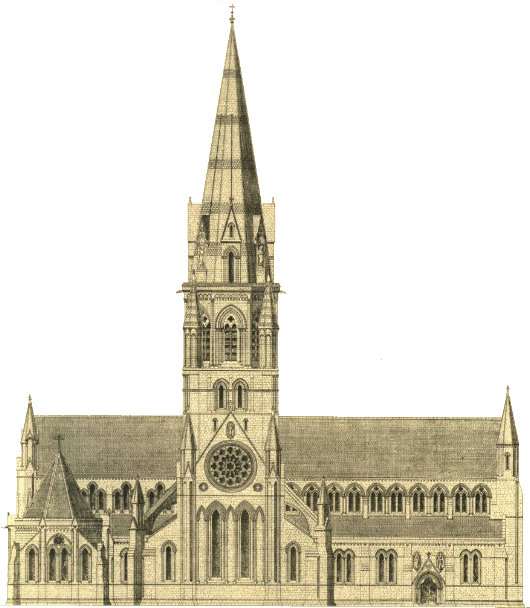
The Cathedral Church of St. Mary (Scottish Episcopal), Edinburgh.
Good to be back
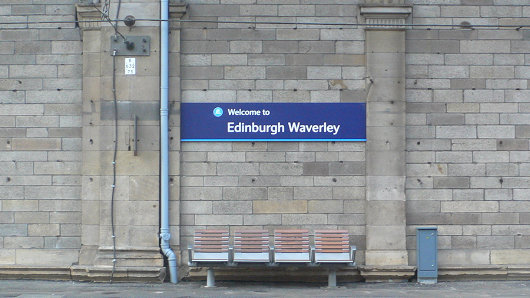
Sad to leave it. (I’m in London now).
From the Number 23 Bus
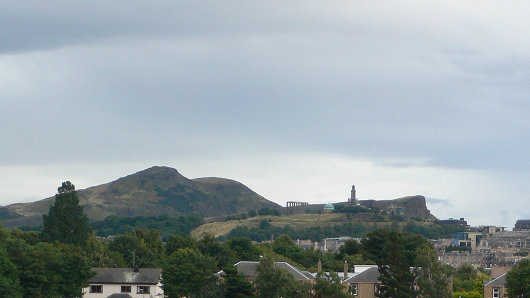
A view of Edinburgh from the top of the no. 23 bus. (more…)
Our Cardinal at the Oratory
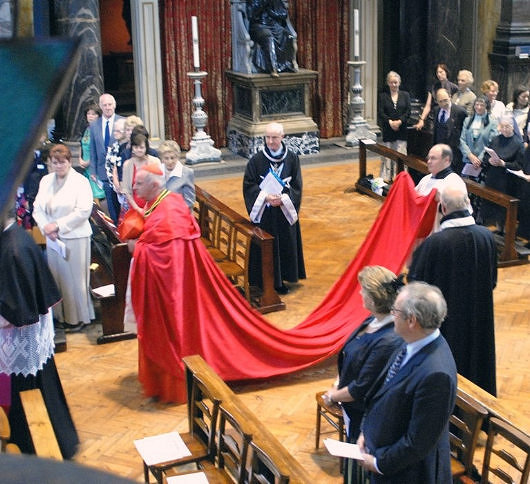
His Eminence Keith Patrick O’Brien, Cardinal Archbishop of St Andrews & Edinburgh, at the Brompton Oratory for the Feast of St. John the Baptist this year.
(From the NLM)
Journey to Scotland
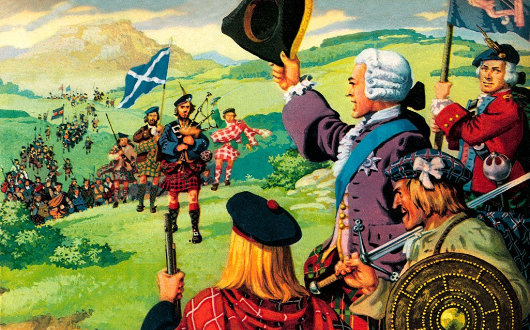
Perhaps foolish to title this entry ‘Journey to Scotland’ as I’ve already crossed the border into England, and indeed my train has just crawled past the beautiful towers of York Minster. I arrived in Scotland on Saturday and neglected to make the pilgrimage to my alma mater of St Andrews but instead spent all of my time in the elegant confines of Edinburgh. Saturday night beheld a splendid repast, including salmon freshly arrived from Ireland, champagne, and brandy cake. After the glories of an old-rite Mass on Sunday morning there was tea aplenty (and brief chats with Gerald Warner and Fra Freddy) before enjoying tankards of champagne near Queen Street Gardens, followed by an excellent late lunch in one of Auld Reekie’s best Italian restaurants, topped off with hot apple pie and a bit of Bas Laubade armagnac (1946).
On Monday I took a break from eating and called at one of my favourite paintings in the National Gallery on the Mound (Pas Mèche by Jules Bastien-Lepage) before a pub lunch with very good friends. A few pints in the Guildford Arms next to New Register House (home to the Court of the Lord Lyon, for those heraldically inclined) led to the standard student dinner of spag bol in a flat off Morningside Road. Yesterday, however, my old friend Richard Demarco led me on a personal tour of Arthur’s Seat and Salisbury Crags in Holyrood Park. A most remarkable guide, with a flair for the dramatic, Richard adeptly explained the ancient significance of the stunning site and declared it a monument even greater than the Pyramids because, unlike those Egyptian constructs, these crags and hills were made not by man but by God.
One of the false conveniences of the modern internet lifestyle is that global websites often redirect themselves to the local version when one is outside the United States. In Montreal just a few weeks ago, I put in “google.com” and automatically got “google.ca”. Similarly, in Scotland, logging out of YahooMail, one is redirected to “yahoo.co.uk” rather than “yahoo.com” regardless of your actual email address. More curiously, however, while passing through Northumberland, I logged on to “google.com” and was redirected to “google.se — Google Sverige”, the Swedish version of Google. Have the Northmen returned, albeit electronically, to claim back the lands that once were theirs?
I am now off to London. My aforementioned friend Richard Demarco is, for lack of a better phrase, big in the arts world of Scotland; this is so despite his strident opposition to much of the arts establishment. Richard believes that divine veneration must be the animating spirit of great art, and that the current reign of nonsense and malarchy in art stems from its divorce from the reality of the Incarnation. For veneration, then, tonight’s eve of the New Year will be commemorated at Brompton Oratory with a Holy Hour and Benediction starting at 11:00pm. Tomorrow’s feast will be marked by yours truly at Spanish Place, where a Solemn High Mass in the Extraordinary Form will be celebrated.
Arrivederci, then, to 2008, and a very happy and blessed new year to all the denizens of this little corner of the web.
Lumsden Requiem in Edinburgh
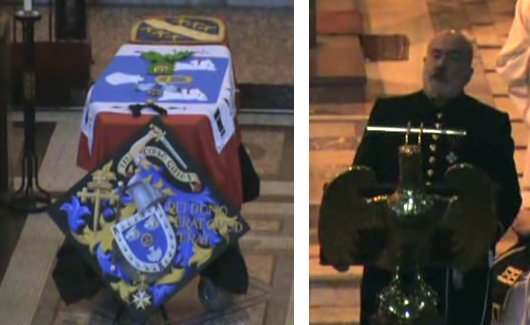
Some good Christian soul was kind enough to put most of our friend David Lumsden‘s funeral at St. Mary’s (Catholic) Cathedral in Edinburgh on YouTube. It was the first Latin requiem in the extraordinary form of the Mass held in the Cathedral for many decades — a fact which David would have particularly enjoyed. Of note is the address given by Robin Angus, embedded below, and of course Gerald Warner’s previously mentioned report should not be missed either.
‘Feudal pomp and Latin Mass at funeral of a Scottish laird’
Gerald Warner reports on the funeral of David Lumsden of Cushnie:
Thursday, September 11, 2008
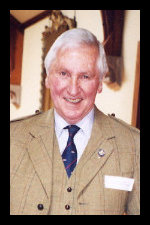 To Edinburgh yesterday, for a melancholy but magnificent and uplifting occasion: the funeral of David Lumsden of Cushnie, Garioch Pursuivant of Arms, restorer of ancient castles and Jacobite romantic. It was held in the Catholic cathedral where, for the first time since Vatican II, the Latin Tridentine Mass was sung, thanks to the permissive rules of Benedict XVI in his motuproprio Summorum Pontificum.
To Edinburgh yesterday, for a melancholy but magnificent and uplifting occasion: the funeral of David Lumsden of Cushnie, Garioch Pursuivant of Arms, restorer of ancient castles and Jacobite romantic. It was held in the Catholic cathedral where, for the first time since Vatican II, the Latin Tridentine Mass was sung, thanks to the permissive rules of Benedict XVI in his motuproprio Summorum Pontificum.
The coffin was draped in the banners of the Order of Malta and the deceased’s arms, with an heraldic hatchment and the decorations of the orders of chivalry to which he belonged. Knights of Malta and of the Constantinian Order processed behind their banner in mediaeval robes. The congregation was filled with peers, chieftains, lairds and splendid eccentrics, the pews awash with tartan. One of the tail-coated ushers was the grandson of a papal marquis. Robin Angus, whose day job is venture capitalist, dressed in the uniform of a papal Knight of St Sylvester, delivered a moving panegyric.
This occasion was a potent reminder of an alternative Scotland, a different pulse from the vulgar, mean-minded, politically correct clones in the abysmal Scottish parliament at Holyrood. It was shamelessly feudal, aristocratic and colourful. Evelyn Waugh would have loved it; Harriet Harridan would have burst her stays. It was reminiscent of the scene in Waugh’s Sword of Honour when, at the funeral of old Mr Crouchback, the members of ancient Catholic Recusant families murmur their sonorous names while the narrator, parodying a wartime poster, concludes: “Their journey was really necessary.”
At the subsequent reception, Lady Mar, whose personal herald David was and who came top of the ballot for the 92 surviving hereditary peers in the House of Lords, was pointedly addressed by Jacobites as “Your Grace”. This was because, although the British state recognises her as 30th Countess of Mar, her ancestor who led the Jacobite Rising of 1715 was created Duke of Mar by the exiled Stuart King James VIII.
Only a few of these Jacobite peerages created by the Stuarts in exile have heirs today. Now that such hereditary peerages no longer bestow an automatic seat in Parliament, it would be a gracious gesture for the Crown to recognise them and so heal old historical wounds. There is a precedent: Spain has recognised the titles of nobility created by the Carlist claimants in exile – Carlism being the Spanish equivalent of Jacobitism.
The dry-as-dust forms issued by government departments are normally very boring; but the most romantic document available online is issued by the Spanish Ministry of Justice, entitled Solicitud de Titulo Nobiliario por: Rehabilitacion/Reconocimiento de Titulo Carlista. It is the formal application for recognition of a title of nobility conferred by the Carlist kings in exile from 1833 to 1936. David Lumsden of Cushnie (RIP) would have appreciated it.
Search
Instagram: @andcusack
Click here for my Instagram photos.Most Recent Posts
- Bicycle Rack April 29, 2024
- Burns Tower April 19, 2024
- Patrick in Parliament March 18, 2024
- Articles of Note: 13 March 2024 March 13, 2024
- Cambridge March 9, 2024
Most Recent Comments
Book Wishlist
Monthly Archives
Categories

